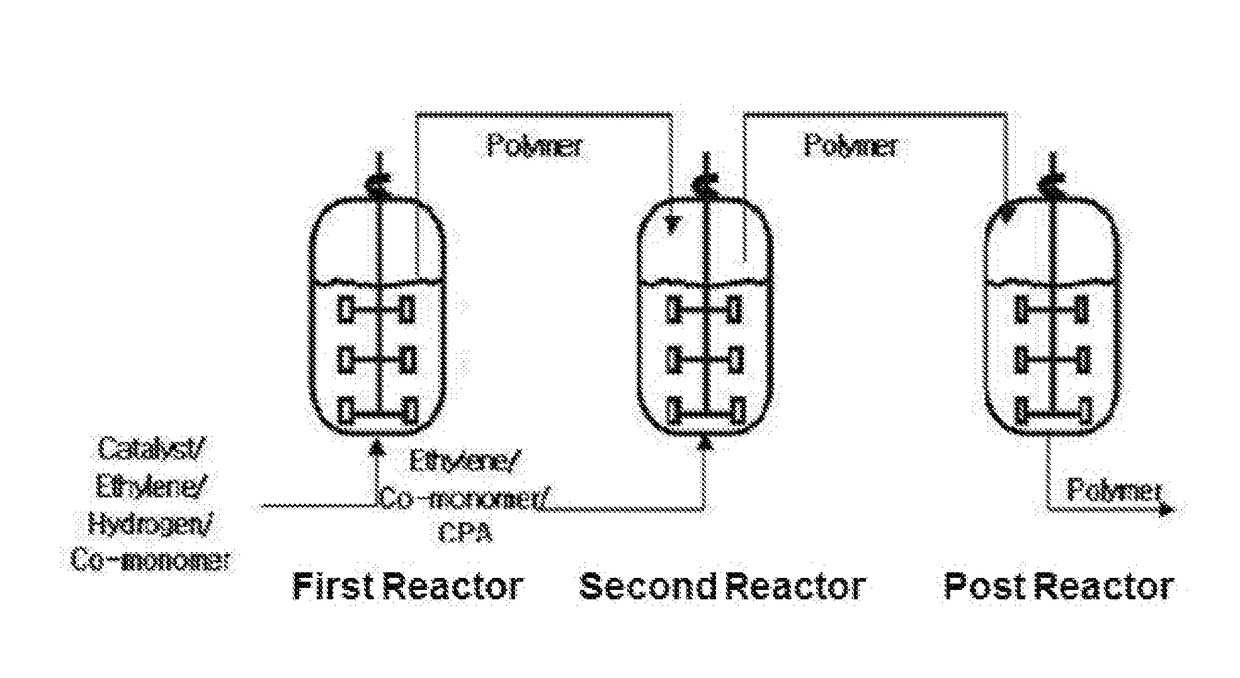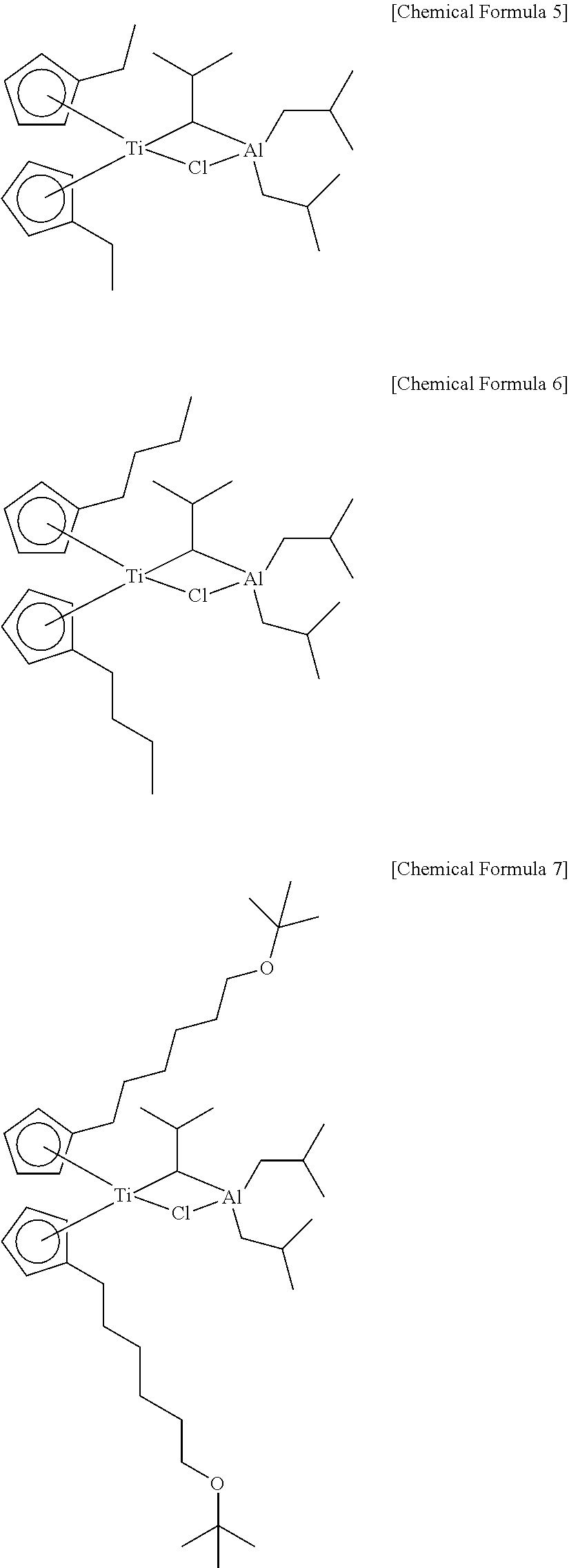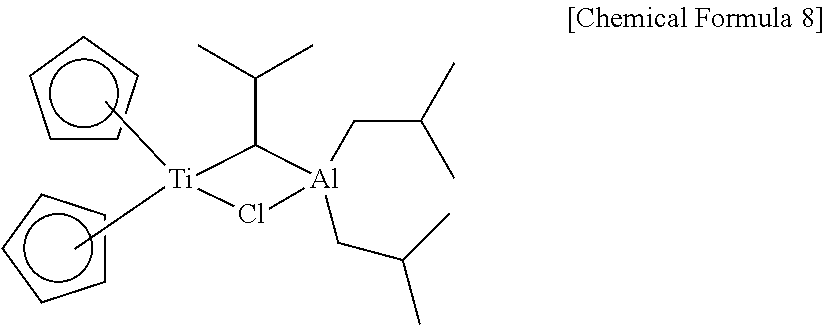Method of preparing polyolefin, and polyolefin prepared thereby
a polyolefin and polyolefin technology, applied in the field of preparation of polyolefins, can solve the problems of reducing extrusion productivity, poor processability of polyolefins prepared using metallocene catalysts, and reducing bubble stability, so as to achieve the effect of effectively preparing a polyolefin, wide multimodal molecular weight distribution, and high molecular weigh
- Summary
- Abstract
- Description
- Claims
- Application Information
AI Technical Summary
Benefits of technology
Problems solved by technology
Method used
Image
Examples
synthesis example 1
[0133]Synthesis of [t-Bu-O(CH2)6—C5H4]2ZrCl2
[0134]t-butyl-O—(CH2)6—C1 was prepared using 6-chlorohexanol according to a method described in the document (Tetrahedron Lett. 2951 (1988)), and reacted with NaC5H5 to obtain t-butyl-O—(CH2)6—C5H5 (yield: 60%, b.p. 80° C. / 0.1 mmHg).
[0135]2.0 g (9.0 mmol) of t-butyl-O—(CH2)6—C5H5 was dissolved in THF at −78° C., and 1.0 equivalent weight of normal butyl lithium (n-BuLi) was slowly added thereto. The temperature was raised to room temperature, and reaction was allowed to proceed for 8 h. This reaction solution was slowly added to a suspension solution of ZrCl4(THF)2 (1.70 g, 4.50 mmol) / THF (30 mL) at −78° C., and then further reacted at room temperature for 6 h to obtain a final reaction solution.
[0136]The reaction solution was dried under vacuum to remove all volatile materials, and then hexane was added to the remaining oily liquid, followed by filtration using a Schlenk glass filter. The filtrate solution was dried under vacuum to remov...
synthesis example 2
[0139]
[0140]2-1. Preparation of Ligand Compound
[0141]2 g of fluorene was dissolved in 5 mL of MTBE, 100 mL of hexane, and then 5.5 mL of a 2.5 M n-BuLi hexane solution was added dropwise thereto in a dry ice / acetone bath, followed by stirring at room temperature overnight. 3.6 g of (6-(tert-butoxy)hexyl)dichloro(methyl)silane was dissolved in 50 mL of hexane, and a fluorene-Li slurry was transferred in a dry ice / acetone bath for 30 min, followed by stirring at room temperature overnight. Simultaneously, 5,8-dimethyl-5,10-dihydroindeno[1,2-b]indole (12 mmol, 2.8 g) was dissolved in 60 mL of THF, and 5.5 mL of a 2.5 M n-BuLi hexane solution was added dropwise thereto in a dry ice / acetone bath, followed by stirring at room temperature overnight. NMR sampling of the reaction solution of fluorene and (6-(tert-butoxy)hexyl)dichloro(methyl)silane was performed to confirm completion of the reaction, and then a 5,8-dimethyl-5,10-dihydroindeno[1,2-b]indole-Li solution was transferred to a dry...
synthesis example 3
[0146]
[0147]3-1. Preparation of Ligand Compound
[0148]2.1 g (9 mmol) of 5,8-dimethyl-5,10-dihydroindeno[1,2-b]indole was added to a 250 mL flask, in which the atmosphere was replaced by an argon atmosphere, and dissolved in 50 mL of THF. 3.9 mL (9.75 mmol) of a 2.5 M n-BuLi hexane solution was added dropwise thereto in a dry ice / acetone bath, followed by stirring at room temperature overnight. Thus, a yellow slurry was obtained. 50 ml of hexane was further injected, and 1.35 g of (6-(tert-butoxy)hexyl)dichloro(methyl)silane was added dropwise using a syringe in a dry ice / acetone bath, and the temperature was raised to room temperature, followed by stirring overnight. A small amount of the reaction product was sampled to confirm completion of the reaction by 1H-NMR. The solvent was dried under vacuum, and then the resulting solid was dissolved in 70 ml of toluene and filtered to remove LiCl. The resulting filtrate was used as is in metallation.
[0149]1H NMR (500 MHz, CDCl3): −0.24 (3H,...
PUM
 Login to View More
Login to View More Abstract
Description
Claims
Application Information
 Login to View More
Login to View More - R&D
- Intellectual Property
- Life Sciences
- Materials
- Tech Scout
- Unparalleled Data Quality
- Higher Quality Content
- 60% Fewer Hallucinations
Browse by: Latest US Patents, China's latest patents, Technical Efficacy Thesaurus, Application Domain, Technology Topic, Popular Technical Reports.
© 2025 PatSnap. All rights reserved.Legal|Privacy policy|Modern Slavery Act Transparency Statement|Sitemap|About US| Contact US: help@patsnap.com



